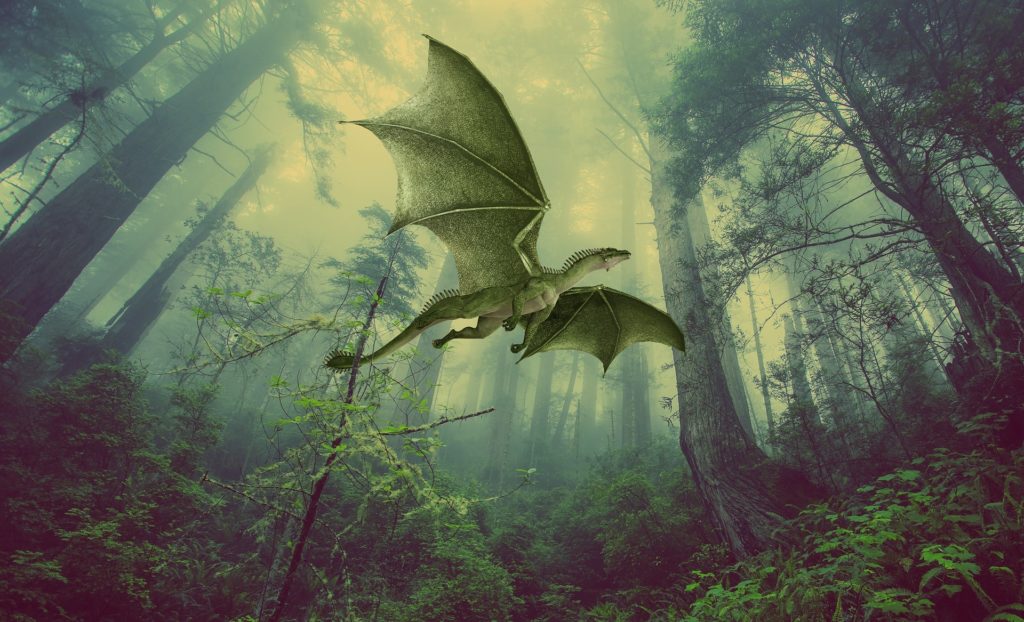No fantasy story is really complete without a dragon or two. But if you thought to add a dragon to your fantasy epic is as easy as just plopping in a random giant lizard onto a scene, think again, friend: in fantasy lore, the creatures we know as dragons can actually be separated into different categories: you have your vanilla dragons, obviously, but you can also have Wyverns, Drakes, and Wyrms.
But what’s the difference between Dragons vs. Wyverns vs. Drakes vs. Wyrms? To answer that, we’ll refer to both history and Dungeons & Dragons, with the latter setting arguably the most influential, not to mention comprehensive, categorization system in all of fantasy.
Dragon

Probably the most recognizable of all fire-breathing creatures (with Salamanders coming in at a very far second), dragons have their roots in history, or, at least, in the mythologies of our ancestors. What’s interesting about dragons is that amongst all the other mythological creatures there are –Griffins or sphinxes or vampires, etc. –it’s only the dragon that is present in nearly all of the world’s mythologies.
Of course, their names and shapes differ depending on the culture, but it’s basically the same creature: scaly, fire-breathing, long-tailed monsters that can be good or evil, depending on their mood. Dragons, both eastern Asian dragons and western European dragons, are also known for being symbols of fortune: both culture’s dragons are symbols of wealth and prosperity, with the former granting treasure to those who it deems worthy, while the latter hoards it. In both culture’s mythologies, dragons are usually sage-like in wisdom, although both vary in terms of cruelty.
In mythologies, dragons are fairly straight-forward: titanic creatures that fly and breathe fire, with western Dragons flying with the help of wings, and eastern Dragons flying with the aid of magic. They’re usually extremely tough, with a scaly, armor-like exterior, and razor talons.
In fantasy epics and pop culture, however, dragons are slightly different: depending on the fantasy franchise, dragons can have various extra features like extra heads, limbs, or special types of breath powers. Their intelligence, too, differs, from animalistic and crude to primordial intelligence bordering on god-like. The latter are often versed in magic, able to teach humans a thing or two, while the former is, while magical, are unable to fully comprehend their powers, which make them more akin to wild beasts more than anything.
In many fantasy franchises, the difference between a dragon and a drake, or a Wyvern and Wyrm, are the number of limbs: dragons will often have 4 limbs: 2 hind legs, 2 front legs, and 2 wings. Talons on each of these limbs are optional.
Wyvern

In mythology, wyverns are pretty much similar to the regular dragon. The word ‘wyvern’ itself is fairly new, with the earliest recorded use dating back to only the 17th century. ‘Wyvern’ is a variation of the Middle English word ‘Wyver’ (itself a fairly new term with no use earlier than the 13th century), which comes from the Old French word ‘wivre’, itself derived from the Latin vīpera: viper.
Modern depictions of the Wyvern can be traced back to the Roman Dacian legion’s “draco” standard, which is depicted as a dragon with wolf-like jaws and multiple tongues of metal. The exact origin of this symbol is unknown, although it was incorporated by the Dacian legions after the end of the Dacian Wars.
Legend has it that the Roman legion had encountered and slain a real-life dragon during their campaign of Dacia (now known as southern Transylvania and the Carpathian mountains). Of course, no real-life evidence supports this, other than the fact that the Dacian Draco, the Welsh Red Dragon and the Golden Dragon of the Wessex Kingdom bear striking similarities despite being thousands of miles and hundreds of years apart. Coincidence, maybe?
In any case, in modern fiction, wyverns are typically presented as physically similar to the regular dragon, albeit slightly less evolved: where the dragon has 6 limbs, arcane knowledge of magic, and supra-human intelligence, the wyvern only has 4 limbs, with minimal to no grasp of any language. Although wyverns are usually depicted as being magical creatures, they are not usually depicted as having supreme control over it, unlike dragons, who are able to teach their ways to hapless mortals.
Wyverns also walk differently in fiction; they’re usually depicted with their wings tucked in to give them the appearance of dragging their knuckles, a far cry from their more regal, strutting dragon cousins. Basically, dragons are to homo sapiens as wyverns are to homo erectus.
Drake

Although it’s etymologically related to the word Dragon (via the Latin ‘draco’, which means serpent), drakes are a modern invention, usually attributed to J.R.R. Tolkien. Tolkien used the words Drake, Wyrm, and Dragon interchangeably, with folklorist Jennifer Walker classifying them into two types: cold and fire. Fire Drakes, as the name suggests, breathe fire, while Cold Drakes either breathe snow and ice, or nothing at all. In Walker’s classifications, Drakes do not fly and are equipped only with 4 legs and no wings.
Because they are modern inventions, Drakes will vary from franchise to franchise: in Magic, The Gathering, Drakes are blue-aligned tribes of flying lizards very similar to Dragons, although much less powerful. In Dungeons and Dragons, Drakes are akin to Wyverns, in that they are simpler creatures but without the power of flight. Drakes either walk on all fours like wolves or walk on their hind legs.
What is similar amongst the franchises is that Drakes are regarded as lesser Dragons; they are either young dragons that have yet to achieve their full potential or as less-evolved Dragons that are even simpler than the Wyvern.
Wyrm
The word ‘Wyrm’ is taken from the Old German ‘Worm’, which in itself is derived from the Norse ‘Ormr’. All three refer to the same thing: a mythological serpent that terrorized townships, hoarded gold, and flew around in bat-like wings. Sound familiar?
In fiction, Wyrms are almost always the most powerful and most intelligent types of Dragons. In video games, Wyrms are often the final bosses or NPC creatures that are the hardest to kill. They have the best drops, the best XP gain, but also, the most lethal in terms of damage.
In fiction, Wyrms are the most ancient kinds of Dragons, usually primordial Dragons or the first type of Dragons to be created. They wield extremely powerful, world-changing magic, and more often than not, are beyond the petty Good-Evil dichotomy of mortals. Of course, some of them actually are evil in nature, but that’s what they are: forces of nature.





